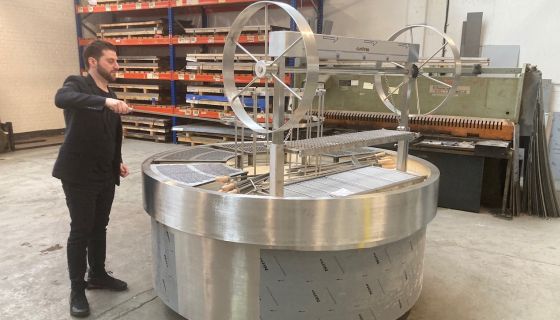One piece of relatively expensive cooking equipment is to be found in the following kitchens: that of Hélène Darroze at The Connaught in London; a new five-star hotel in Zanzibar; the kitchens of Sexy Fish in London and Miami; numerous kitchens in Dubai, Doha and Saudi Arabia; Skibo Castle in Scotland; and one in Tbilisi, Georgia.
The equipment is a grill, manufactured by the Clay Oven Company in a 40,000 sq ft (3,700 m2) industrial unit in the less-than-spectacular surroundings of an industrial estate in Perivale, west London, close to the A40. And the man behind the success of this company is a 37-year-old, second-generation immigrant, Dr Levon Gulian, MBBS BSc, initials which make him a fully qualified doctor as well as an accomplished grill designer. (That's him above with one of the company's asado flame grills.)
The company was started by his father, an architect, who was called to the site meeting of a new London restaurant in 1974 where, on opening the tandoor oven that was to be the centrepiece of the new kitchen, he found it to have been completely smashed. His father volunteered to design and build a new one and an unexpectedly bright future for the family was born.
It is still very much a family business in which Levon’s mother continues as the company secretary. Its initial focus was on tandoor ovens for Indian restaurants. Levon spent his childhood working in the factory, playing with clay and learning to weld by the age of 12. Every family trip in the Renault Espace involved a visit to a restaurant, as there was a tandoor oven installed in the luggage compartment for demonstration purposes.
Having graduated in medicine, Levon felt the call of the family business and in 2010 he moved in. His timing was perfect. It was the beginning of an era when everyone was falling in love with pizza and when today’s top chefs were just beginning to appreciate and understand the attractions of open-flame cooking and the benefits grilling can bring to meat, most obviously, but also to fish and vegetables.
‘Two other factors have helped the growth of our business’, Gulian explained, sitting in an office surrounded by 13 different grills on which their chef, Isaac, was grilling steaks, chicken and pork over gas and charcoal. ‘The first is the manner in which kitchen designers have seen the benefits of incorporating the sight of the flames and the aromas that emanate from them into the overall design of the kitchen. This is achieved by the process of “burning” imitation logs via a gas burner. And the second is that grills can make up for a less-skilled workforce, a trend that has become obvious over the past decade.’
Every order begins with an enquiry from the chef or a restaurateur. Gulian listens to their ambitions before beginning a pencil drawing. What, I asked him, are the major design constraints?
‘Extract is the key’, came his response, ‘although with modern extract equipment that has become less of an issue. And I always need to know the size of the restaurant – how many customers does it have to serve – to ensure that the grill can cope with demand.’ I asked him whether at this stage any request had met with his response ‘it's impossible’. ‘I don’t think so, although we did get a request for a grill using lava that we had to say was not possible’, he added with a smile.
Once finished, the hand drawing is replaced by a computer drawing in the design office. Here, Gulian showed me a sheaf of paper, their work in progress. ‘This is a system I adapted from my days in the hospital. Where there were patients’ names there are now details of all their orders with destinations all over the world and their progress. From receiving an enquiry to completion takes about three months’, he continued.
The design passes to the production on the ground floor where a team of a dozen men work on a variety of different grills. There are the traditional stone-hearth pizza ovens. There are duck ovens, electric-, gas- or wood-fired, one of which has been exported to Hong Kong, Gulian proudly told me. There is the clay grill, which incorporates a hand-crank mechanism and has the characteristics of an Argentine asado. Then there are the custom designs, a monster for Neil Rankin’s Mexican restaurant Temper in London’s Soho and one for a Brazilian steakhouse in Dubai that most closely resembles a spaceship. And then there is the Shahi range of tandoors, which represent the origins of the company.
These are the most basic, at around £1,000 each (€1,210/$1,340), but they proved extremely popular during lockdown when the demand for takeaway food favoured the traditional Indian Balti house, which saw a tremendous renaissance. And their most expensive oven? ‘It was a four metre by four metre [13 x 13 ft] barbecue island with three curved dual-fuel gas burners, all based around a central gas-fired torch that resembled an Olympic torch. That cost £60,000 and was shipped last year to Bluewaters Island, Dubai.’
Mike Davies, chef/proprietor of London’s Camberwell Arms, commented, ‘We bought our first hybrid charcoal and gas robata-style grill in 2014 when we opened because I have always loved food cooked over solid fuel. Being able to use our choice of woods or charcoal for complex smoke flavours but retain the consistency of gas seemed a perfect solution for our menu and has continued to form the backbone of our menu-writing to this day.’
What about future trends in his world, I enquired? ‘There is definitely a move away from fossil fuels to electricity’, Gulian continued, before adding, not wanting to appear to be left behind, ‘last year during lockdown we designed an electric barbecue capable of generating heat at 500 °C [930 °F]. It is pretty awesome.’
The Clay Oven Company Perivale, London













